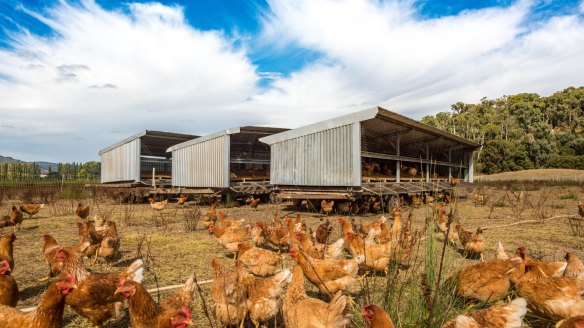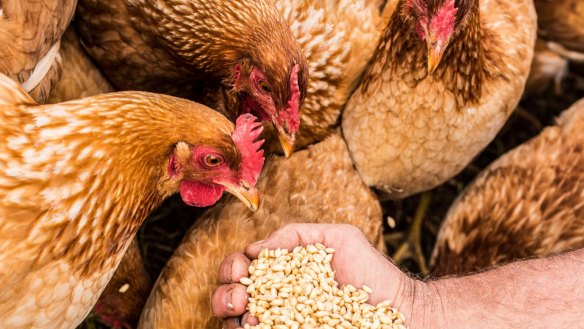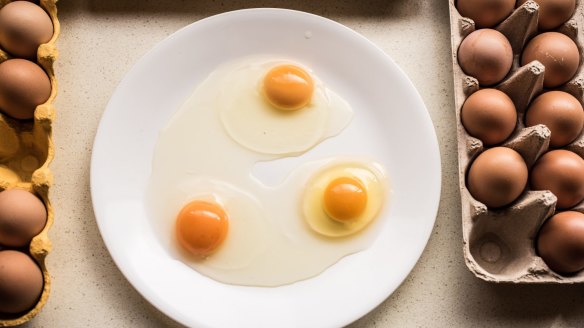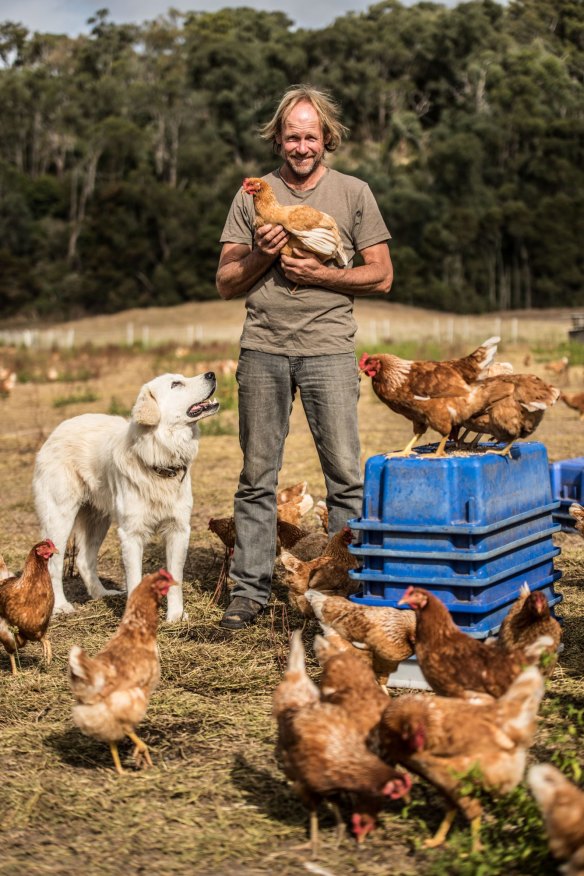Meet the farmer whose eggs cost $15 a dozen

- Are the $15 eggs worth it? Skip down to the taste test
- The Goog Food Guide: All your egg questions answered
These could be the most expensive eggs in the country. They sell for up to $15 a dozen yet at first glance appear no different from a carton of supermarket eggs that cost less than a third of the price.
While eggs from caged birds can sell for as little as $3 a dozen, the cost for free-range eggs has edged up around $6 to $7 a dozen while organic eggs are heading over the $10 mark.

Caged hens spend their life behind wire with an area about the size of an A4 piece of paper to move around. Free-range birds have access to the outdoors and if they do step outside can see as many as 10,000 birds to the hectare.
We took a trip to the Victorian farm considered to have some of the highest standards of animal husbandry and egg quality to see just what goes into making eggs this costly and to see if it really is worth paying $15 for a dozen eggs.
The farm in question is Bullfrog Gully. It lies on the banks of the Merriman Creek about 30 kilometres south east of Traralgon in Victoria's Gippsland region.

The farmer is Ian Onley. He turned his back on conventional farming more than 20 years ago to grow vegetables using biodynamic practices. No chemical fertilisers or sprays. Just compost and hard work. When the millennial drought struck, he moved to chooks, raising his hens out in open pasture.
His aim was to go out of his way to make sure his flocks were healthy, well-fed, watered and safe.
Feeding time

He has two flocks of around 1000 birds each. He hand feeds them twice a day: to maintain biodynamic (BD) certification, Onley must give his flock certified BD grain. This costs him $800 a tonne. The cost of conventional wheat for animal feed is around $200 a tonne. At any one time there could be $20 000 tied up in wheat and barley sitting in the silos on the farm. Add to this the transport costs, and grain becomes the largest single expense on Bullfrog Gully Farm. Laying chickens also need a high level of protein in their feed to maintain their health and still lay an egg each day. "Laying hens need protein. Most laying pellets (commercial chicken feed) contain animal meal, blood and fat," Onley says with a hint of disdain. "I won't use animal meal because once the chickens get a taste for it, it affects their behaviour. They start pulling out each other's feather and they start vent pecking." This last behaviour is where one chicken will peck at another's cloaca as she is laying an egg. The thin skin is under pressure at this point and usually results in a loss of blood. That is why most laying hens have part of their beak removed. Onley's chickens' beaks are fully intact. Onley also comments that the fat component of the animal meal can be rancid which he maintains imparts an off flavour to the eggs.
Instead of using meat meal, Onley makes his own yoghurt to feed his hens. He wakes before dawn every morning and milks his small mixed herd of Friesian and Jersey cows. Their milk is rich, creamy white and releases a sweet aroma as it is pumped into a tank. An old steel tank, standing outside the dairy, surrounded by weeds and sitting, unrefrigerated, in the sun. This exceptionally high-quality milk will never be consumed by a human. Instead it sits in this old tank outside slowly curdling and turning into a great vat of yoghurt. After a day or so fermenting the thick curds are poured into buckets and then mixed with the grain and fed to the hens. The grain, however, is not served plain. Before feeding to the chickens it is soaked in water in small plastic crates and allowed to sprout. This makes the grain more digestible and the nutrients more accessible to the birds. It is also very labour intensive and time-consuming. His birds are very quiet and very passive. Normally chickens scatter quickly when humans come. Their very sedate nature is an impediment to doing things quickly in their outdoor pen. When Onley arrives on his tractor towing a trailer, he has had to build a device around the wheels to gently move them out of harm's way so they don't get squashed by the tyres.
Labour pains
The chickens' health and safety are paramount to Onley. The birds are housed in sheds, built by Onley, mounted on old caravan chassis and graze outdoors during the day with 1000 birds to 0.75 of a hectare. Every day the sheds are moved and the outdoor pens are moved regularly not only so the birds have access to fresh grass but also to rest the pastures on which the birds graze. The pens are made of electric mesh and although light, take time to assemble and reassemble. The birds graze on the creek floodplain which is surrounded by a forest-cloaked escarpment. While beautiful, it is also home to predators such as wedge-tailed eagles and foxes. To keep the foxes at bay are two nervous alpacas. To keep the eagles away are large white Maremma dogs (their feed adding another cost). The second largest cost is the labourers who join Onley on the farm to help with maintenance and also the collecting and processing of the eggs. Onley's flock only produces 700 dozen eggs a week so there is not a lot of product on which those costs can be amortised.
Weather permitting
"The other big problem is climate," says Onley. Large and rapid dumps of rain can see the creek rise and flood the farm. While the chickens are safe in their raised coops the floods damage the pastures. "This last few years, with the dry, we've seen very cold winters and very bad frosts," says Onley. This saw Onley lose almost half of last year's flock where he would have to bury a wheel barrow full of dead chickens every second day. "Night after night these bloody frosts," he pauses. "It's all too much for me. This is my last season," he says, his voice quavering. "When these girls have finished laying that will be it. This is my last flock."
Taste test
Are these eggs worth it?
While at Bullfrog Gully we taste-tested three different eggs to see if there was much difference between them. One from caged chickens, one from a free-range farm and a carton of Bullfrog Gully Eggs. The caged eggs are $4.50 a dozen which is the average price for most caged eggs. The lowest price we have seen is $3 a dozen. The free-range eggs cost $6.33 and came from a farm where the stocking density is 1500 birds per hectare. The Bullfrog Gully eggs cost between $11 and $15 dollars a dozen depending on the retailer.
Onley cracks one egg from each carton onto a plate. The albumen of the cage and free-range eggs split and ooze away from the yolk. The albumen from the Bullfrog Gully eggs clings tightly to the yolk and is thick and viscous. The yolk of the cage egg falls back into the white and is a pleasing orange, the yolk of the free range egg is a very deep orange. The yolk of Onley's egg is pert and an unremarkable orange colour. The difference between the intensity of orange is that birds fed on pellets produce really orange yolks because there can be food colouring added to the feed. These food colourings are made from naturally occurring beta carotenes derived from marigold flowers and capsicums. Egg producers can work out what colour they want their yolks and request the feed producer to add more or less colouring. The light orange colour in the Bullfrog Gully egg yolks comes from the beta carotene in the grass.
On the stove is a pot of simmering water. Onley carefully cracks one of each egg into the water. Perfectly poached, I try them. The caged egg has an "eggy" sulphurous note but is unremarkable in every other way. The free-range egg, while it has a more colourful yolk has, unexpectedly, less flavour than the caged egg. The Bullfrog Gully egg is a very different beast. It has more white surrounding the yolk and the white is smooth and slightly soft. With the knife, I rupture the yolk and a thick golden liquid, thicker than pouring cream, spills out. The aroma is chicken like, a definite pleasant poultry smell. The flavour is quite overwhelming, like the best concentrated chicken soup and a sense of deliciousness that feels like an umami bomb has just gone off in my mouth. It is remarkably good. I suggest to Onley that he tries the other eggs against his. "Nah thanks mate," he says. "I know how the chickens were raised and what they were fed on."
To find a Bullfrog Gully stockist near you, and more about other biodynamic products, visit biodynamic.com.au.
